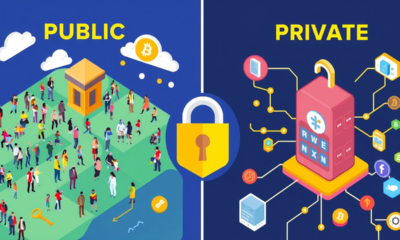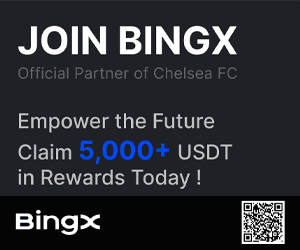Blockchain Education
What Is Blockchain Technology? A Beginner-Friendly Explanation

|
Getting your Trinity Audio player ready...
|

What Is Blockchain Technology?
Introduction
Blockchain technology, often associated with cryptocurrencies like Bitcoin, is a revolutionary concept that has the potential to transform various industries. At its core, blockchain is a decentralized digital ledger that records transactions across multiple computers in such a way that the registered transactions cannot be altered retroactively. This article aims to provide a beginner-friendly explanation of blockchain technology, exploring its fundamental principles, applications, and the future it promises. By the end of this read, you’ll have a clear understanding of what blockchain is and how it can impact your life.
What Is Blockchain Technology?
Blockchain technology is a distributed database or ledger that is shared among the nodes of a computer network. As a database, it stores information electronically in digital format. Blockchains are best known for their crucial role in cryptocurrency systems, such as Bitcoin, for maintaining a secure and decentralized record of transactions. The innovation with blockchain is that it guarantees the fidelity and security of a record of data and generates trust without the need for a trusted third party.
How Does Blockchain Work?
- Blocks and Chains:
- Blocks: Each block in a blockchain contains a number of transactions. Every time a new transaction occurs on the blockchain, a record of that transaction is added to every participant’s ledger.
- Chains: These blocks are linked together in a chronological order, forming a chain. Each block contains a cryptographic hash of the previous block, a timestamp, and transaction data.
- Decentralization:
- Peer-to-Peer Network: Unlike traditional databases, blockchains are decentralized and distributed across a network of computers. This means that no single entity has control over the entire network.
- Consensus Algorithms: To ensure the integrity of the blockchain, consensus algorithms are used. These algorithms help the network agree on the validity of a transaction before it is added to the blockchain. Popular consensus algorithms include Proof of Work (PoW) and Proof of Stake (PoS).
- Immutability:
- Tamper-Proof: Once a transaction is recorded on a blockchain, it cannot be altered. This is achieved through cryptographic hashing and the distributed nature of the network. If anyone tries to alter a transaction, it would require changing all subsequent blocks, which is computationally infeasible.
- Transparency:
- Public and Private Blockchains: While some blockchains are public and accessible to anyone, others are private and require permission to join. Regardless of the type, all transactions are visible to all participants, ensuring transparency.
Key Features of Blockchain Technology
- Security: The decentralized and cryptographic nature of blockchain makes it highly secure against cyber threats.
- Transparency: All participants in a blockchain network can view the transaction history, which promotes accountability.
- Decentralization: No single entity has control over the network, reducing the risk of central points of failure.
- Traceability: Each transaction is recorded with a unique identifier, making it easy to trace the history of assets.
- Efficiency: Blockchain can streamline processes by eliminating intermediaries, reducing costs, and increasing speed.
Applications of Blockchain Technology
- Finance:
- Cryptocurrencies: Bitcoin, Ethereum, and other cryptocurrencies use blockchain to facilitate secure, peer-to-peer transactions.
- Smart Contracts: These are self-executing contracts with the terms of the agreement directly written into code. They automatically enforce and execute the terms of a contract when conditions are met.
- Cross-Border Payments: Blockchain can significantly reduce the time and cost associated with international money transfers.
- Supply Chain Management:
- Tracking and Tracing: Blockchain can provide a transparent and immutable record of the supply chain, from the origin of raw materials to the final product.
- Counterfeit Prevention: By recording every step of the supply chain, blockchain can help prevent the sale of counterfeit goods.
- Healthcare:
- Patient Records: Blockchain can securely store and share patient records, ensuring they are complete and accurate.
- Drug Traceability: It can help track the production and distribution of pharmaceuticals, reducing the risk of counterfeit drugs.
- Voting:
- Secure Voting Systems: Blockchain can be used to create transparent and tamper-proof voting systems, increasing trust in electoral processes.
- Real Estate:
- Property Titles: Blockchain can simplify the process of buying and selling property by providing a secure and transparent record of ownership.
- Smart Leases: These can automate rental agreements, ensuring timely payments and reducing disputes.
Current Data and Trends
- Market Growth: The global blockchain market is expected to grow from $3.0 billion in 2020 to $39.7 billion by 2025, at a CAGR of 67.3%.
- Adoption Rates: According to a survey by Deloitte, 55% of companies are already using or planning to use blockchain technology in the next year.
- Regulatory Environment: Governments around the world are increasingly recognizing the potential of blockchain and are developing regulations to support its growth.
Practical Tips for Understanding and Using Blockchain
- Educate Yourself:
- Start with the basics: Understand the fundamental concepts of blocks, chains, and consensus algorithms.
- Explore real-world examples: Look into how different industries are using blockchain to solve specific problems.
- Experiment with Cryptocurrencies:
- Try small transactions: Buy a small amount of Bitcoin or Ethereum to get familiar with the process.
- Use crypto wallets: Explore different types of wallets, such as hardware wallets and mobile apps.
- Join a Blockchain Community:
- Participate in forums: Join online communities like Reddit’s r/Bitcoin and r/ethereum to stay updated on the latest developments.
- Attend webinars and workshops: Many organizations offer free resources to help beginners understand blockchain.
- Consider Blockchain for Business:
- Evaluate potential use cases: Identify areas in your business where blockchain can add value, such as supply chain management or secure data storage.
- Collaborate with experts: Work with blockchain consultants or developers to implement solutions tailored to your needs.
- Stay Informed:
- Follow industry news: Keep up with the latest trends and innovations in blockchain by following news outlets like CoinDesk and Cointelegraph.
- Read whitepapers: Delve deeper into the technical aspects of blockchain by reading whitepapers and research papers.
Challenges and Considerations
- Scalability:
- Transaction Speed: While blockchain is secure, it currently faces challenges with transaction speed, especially in public blockchains like Bitcoin.
- Energy Consumption: Proof of Work (PoW) consensus algorithms, used by Bitcoin, are energy-intensive. Alternative algorithms like Proof of Stake (PoS) are being developed to address this issue.
- Regulation:
- Legal Frameworks: The regulatory environment for blockchain is still evolving, which can create uncertainty for businesses.
- Compliance: Ensure that your blockchain implementation complies with relevant laws and regulations to avoid legal issues.
- Integration:
- Existing Systems: Integrating blockchain with existing systems can be complex and costly.
- Interoperability: Different blockchain networks often lack interoperability, making it difficult to transfer data or assets between them.
The Future of Blockchain Technology
- Quantum Computing: The advent of quantum computing could pose a threat to blockchain’s security, but researchers are already working on quantum-resistant algorithms.
- Internet of Things (IoT): Blockchain can enhance the security and efficiency of IoT devices by providing a secure and decentralized platform for data exchange.
- Decentralized Finance (DeFi): DeFi platforms are using blockchain to offer financial services without the need for traditional intermediaries, such as banks.
Conclusion
Blockchain technology is more than just the backbone of cryptocurrencies; it is a powerful tool that can revolutionize various industries. By understanding its key features, applications, and challenges, you can position yourself to take advantage of the opportunities it presents. Whether you’re a business owner, a tech enthusiast, or simply curious about the future of technology, exploring blockchain can open up new horizons. Start by educating yourself, experimenting with cryptocurrencies, and joining a community to stay informed.
Call to Action
Ready to dive deeper into the world of blockchain? Consider enrolling in a beginner-friendly course or joining a local blockchain meetup to connect with like-minded individuals and experts. The future is decentralized, and your journey into blockchain can begin today!

Blockchain Education
How Token Standards Like ERC-20 and BEP-20 Shape Ecosystems


How Token Standards Like ERC-20 and BEP-20 Shape Ecosystems
Introduction
In the rapidly evolving world of blockchain and cryptocurrencies, the importance of token standards cannot be overstated. Token standards like ERC-20 and BEP-20 shape ecosystems by providing rules and guidelines for creating and managing tokens on their respective networks. Understanding these standards is vital for developers, investors, and users alike, as they enhance interoperability, facilitate DeFi applications, and foster innovation. This comprehensive article dives deep into the implications of these token standards, their common features, and how they influence blockchain ecosystems.
What Are Token Standards?
Token standards are essentially protocols that define how tokens are created, transferred, and how they function within their respective ecosystems. They ensure a uniform approach that developers can rely on when creating new cryptocurrencies or tokens. The two most significant standards today are:
- ERC-20 – Ethereum Request for Comment 20, used on the Ethereum network.
- BEP-20 – Binance Smart Chain Evolution Proposal 20, used on the Binance Smart Chain.
Understanding these standards is crucial, especially when considering their impact on decentralized finance (DeFi), token trading, and dApps (decentralized applications).
The Significance of ERC-20
Overview of ERC-20
ERC-20 is the most widely used token standard on the Ethereum network, introduced in 2015. It allows for the creation of fungible tokens, meaning each token is identical and interchangeable with another. This standard has fueled the ICO (Initial Coin Offering) boom, as it allows new projects to easily launch their tokens on Ethereum, thereby enjoying its vast ecosystem.
Features of ERC-20
Some of the key features of ERC-20 include:
- Interoperability: Tokens created under this standard can interact seamlessly with various Ethereum-based applications, exchanges, and wallets.
- Smart Contracts: ERC-20 tokens rely heavily on Ethereum’s smart contract functionality, which automates and governs the token’s operations.
- Standardized Functions: ERC-20 tokens implement a set of standardized functions (such as transfer, approve, and transferFrom), which simplifies the process for developers.
Impact on Ecosystems
The widespread adoption of ERC-20 has allowed massive growth within the Ethereum ecosystem. Projects often prefer ERC-20 tokens, providing investors and users with myriad options across decentralized exchanges (DEXs), DeFi applications, and more.
The Role of BEP-20
Overview of BEP-20
BEP-20 is a token standard designed specifically for the Binance Smart Chain (BSC), which has gained significant popularity due to its lower fees and faster transaction times compared to Ethereum. BEP-20 tokens are also fungible and compatible with Ethereum’s ERC-20 tokens, offering greater flexibility and interoperability.
Key Features of BEP-20
Some salient features of BEP-20 include:
- Lower Fees: Transactions involving BEP-20 tokens generally incur lower gas fees compared to ERC-20 transactions, making them more accessible for smaller investors.
- Compatibility: BEP-20 tokens can also interact with ERC-20 tokens, thus fostering a more integrated ecosystem across different blockchain systems.
- Customizability: Developers can easily customize their tokens under the BEP-20 standard to fit unique project requirements.
Ecosystem Growth
The emergence of BEP-20 has driven a surge of innovation, particularly in the DeFi sector. Many decentralized applications (dApps) and financial products have launched on BSC, taking advantage of the standard’s flexibility and cost-effectiveness.
Comparing ERC-20 and BEP-20
While both ERC-20 and BEP-20 have similar functionalities and aim to foster robust ecosystems, several differences set them apart:
| Feature | ERC-20 | BEP-20 |
|---|---|---|
| Blockchain | Ethereum | Binance Smart Chain |
| Transaction Fees | Generally higher | Generally lower |
| Speed | Slower transactions | Faster transactions |
| Ecosystem | Extensive DeFi options | Rapidly growing DeFi |
| Token Compatibility | Primarily Ethereum-based | Interoperable with Ethereum-based tokens |
The Influence on DeFi and dApps
DeFi Revolution
The rise of token standards like ERC-20 and BEP-20 has spearheaded the DeFi revolution, enabling:
- Liquidity Pools: Users can provide liquidity using various tokens, earning returns on their investments.
- Lending Protocols: Token standards allow peer-to-peer lending solutions that don’t require intermediaries.
- Yield Farming: Investors can maximize returns by staking tokens and participating in decentralized protocols.
dApp Development
With robust token standards in place, developers can focus on creating innovative dApps. These applications can leverage token functionalities, allowing for enhanced user experiences and extensive integration across platforms. Additionally, developers enjoy a larger user base, as these standards have established trust and interoperability within the ecosystems.
Conclusion
Token standards like ERC-20 and BEP-20 shape ecosystems in ways that enhance interoperability, streamline development, and spawn a plethora of financial applications. As blockchain technology and DeFi continue to evolve, these standards will play a crucial role in supporting innovation and driving adoption.
Understanding the intricacies of these token standards not only empowers developers to create more effective applications but also enables investors and users to navigate the burgeoning landscape of blockchain technology wisely.
Call to Action: Stay informed and consider how you can leverage token standards in your projects or investments. Embrace the future and explore the endless possibilities within the blockchain ecosystem!
Blockchain Education
What Are Smart Contracts and How Do They Work?


What Are Smart Contracts and How Do They Work?
Introduction
In the realm of blockchain technology and cryptocurrencies, one term that surfaces frequently is “smart contracts.” But what are smart contracts and how do they work? This article demystifies this innovative concept, explains its functioning, and sheds light on its growing importance in various sectors.
What Are Smart Contracts?
Smart contracts are self-executing contracts with the terms of the agreement directly written into code. They automatically enforce and execute the terms of the contract once certain conditions are met. Smart contracts run on blockchain technology, making them secure, transparent, and immutable.
Key Features of Smart Contracts
- Self-Execution: Smart contracts automatically execute actions based on predefined rules. This eliminates the need for intermediaries.
- Transparency: All parties involved can see the terms and conditions of the contract, creating trust and reducing disputes.
- Security: Smart contracts are secured through cryptography, making them resistant to tampering and fraud.
- Cost-Effectiveness: By removing intermediaries, smart contracts can significantly reduce transaction costs.
How Do Smart Contracts Work?
1. Creation
Smart contracts are created using programming languages such as Solidity (commonly used with Ethereum) or other blockchain-specific languages. Developers encode the agreement’s terms and conditions in the smart contract’s code.
2. Deployment
Once created, the smart contract is deployed onto a blockchain platform. This deployment ensures that the contract is immutable and accessible to all parties involved.
3. Execution
The contract will execute when the predefined conditions are met. For example, if a specific date arrives, or certain data inputs are received, the contract triggers the agreed actions.
4. Verification
Once executed, the network nodes verify the actions taken by the smart contract, ensuring that all conditions were satisfied appropriately.
5. Settlement
After verification, the results of the contract (such as money transfer or asset exchange) are executed, and the transactions are recorded onto the blockchain.
Advantages of Smart Contracts
Smart contracts offer a plethora of advantages, particularly in how they enhance efficiency and security in transactions:
- Reduced Costs: By automating processes, smart contracts cut down on transaction fees typically associated with intermediaries.
- Faster Transactions: Traditional contracts often require human intervention and processing time. Smart contracts execute in real-time, speeding up the transaction process.
- Increased Trust: With the entire contract visible on the blockchain, participants can trust that the terms are being adhered to without needing third-party validation.
Real-World Applications of Smart Contracts
1. Financial Services
Smart contracts are revolutionizing industries such as banking and insurance. They can automate loan processing and claims management, significantly reducing administrative burdens.
2. Supply Chain Management
In supply chains, smart contracts can track the movement of goods. They ensure all parties fulfill their obligations before payment is released, thus increasing accountability.
3. Real Estate Transactions
Smart contracts can facilitate property sales by automating escrow services and recording transactions on the blockchain, ensuring transparency and reducing fraud.
4. Digital Identity Verification
Smart contracts can be used to create decentralized digital identities, allowing individuals to control their personal data while providing necessary verification to third parties.
Challenges Facing Smart Contracts
While the benefits of smart contracts are numerous, there are also challenges that need addressing:
- Coding Errors: If a smart contract is poorly coded, it can lead to unintended consequences or vulnerabilities.
- Legal Status: The legal recognition of smart contracts varies by jurisdiction, which can complicate their adoption.
- Interoperability: Different blockchains may have varying standards, making it challenging for smart contracts to work seamlessly across platforms.
Conclusion
Understanding what are smart contracts and how do they work is crucial in navigating the rapidly evolving technological landscape. As industries continue to integrate blockchain technology, smart contracts offer a promising future for greater efficiency and security in transactions.
Call to Action
Are you ready to leverage smart contracts in your business? Explore the possibilities they present and consider how you can integrate them into your operations for streamlined efficiency and transparency.
Blockchain Education
The Top 5 Blockchain Lottery Platforms Revolutionizing Gaming in 2025


The Top 5 Blockchain Lottery Platforms Revolutionizing Gaming in 2025
Blockchain technology has disrupted industries worldwide, and the online lottery sector is no exception. By leveraging blockchain’s inherent transparency, security, and fairness, these platforms are redefining trust in gaming. As of 2025, several blockchain lottery platforms have emerged as leaders, offering innovative features, robust reliability, and exceptional user experiences. In this article, we explore the top five platforms that are setting new standards in the blockchain lottery space.
1. Xalora: Pioneering Transparency and Decentralization
Xalora stands at the forefront of blockchain lotteries, offering a fully decentralized platform powered by cutting-edge smart contracts. Its commitment to transparency and fairness has made it the gold standard for blockchain-based gaming.
Key Features of Xalora:
- Provably Fair System: Every draw on Xalora is verifiable on the blockchain, ensuring complete transparency and eliminating any possibility of manipulation.
- Smart Contract Automation: Prizes are distributed instantly after each draw, removing delays and enhancing user trust.
- Cross-Chain Compatibility: Xalora supports multiple blockchain networks, allowing users to participate with their preferred cryptocurrencies.
- Low Transaction Costs: By reducing overhead costs associated with traditional lotteries, Xalora offers an economical alternative for players.
- Global Accessibility: Unlike conventional lotteries restricted by geography, Xalora is accessible to users worldwide, democratizing participation.
Xalora’s intuitive interface caters to both newcomers and seasoned crypto enthusiasts, while its community-driven ethos fosters loyalty and growth. This combination of innovation and inclusivity has cemented Xalora’s position as a leader in the blockchain lottery space.
2. LuckyBlock: Tokenized Innovation
LuckyBlock has carved out a niche for itself with its unique token-based ecosystem, blending lottery participation with cryptocurrency investment opportunities.
Why LuckyBlock Stands Out:
- Native Token Integration: Users engage with LuckyBlock using its native token, which not only facilitates participation but also offers potential value appreciation over time.
- Transparent Random Number Generation (RNG): LuckyBlock employs a provably fair RNG system, ensuring every draw is unbiased and trustworthy.
- Community-Centric Rewards: Beyond lottery winnings, participants benefit from the platform’s tokenomics, creating additional incentives for long-term engagement.
LuckyBlock’s innovative approach to combining gaming and blockchain economics has earned it a loyal following among crypto-savvy users.
3. PoolTogether: The No-Loss Lottery
PoolTogether introduces a groundbreaking concept—the “no-loss lottery.” Unlike traditional lotteries where participants risk losing their stake, PoolTogether allows users to retain their principal while competing for prizes generated from pooled interest.
What Makes PoolTogether Unique:
- Risk-Free Participation: Players deposit funds into a shared pool, earning interest collectively. Prizes are awarded from the accrued interest, ensuring no one loses their initial investment.
- Smart Contract Management: Automated smart contracts handle deposits, prize distributions, and withdrawals, providing a seamless user experience.
- Gamified Savings: By combining entertainment with financial responsibility, PoolTogether appeals to users seeking a fun yet prudent way to grow their assets.
This innovative model has attracted a diverse audience, from casual gamers to those looking for creative ways to save and earn.
4. TrueFlip: Transparency Meets Innovation
TrueFlip distinguishes itself through its commitment to complete transparency and a diverse range of blockchain-based games. While rooted in traditional lottery mechanics, the platform incorporates modern gameplay elements to enhance user engagement.
Key Highlights of TrueFlip:
- Publicly Auditable Results: All game outcomes are recorded on the blockchain and available for public verification, reinforcing trust in the system.
- Diverse Game Portfolio: Beyond lotteries, TrueFlip offers various blockchain games, catering to different preferences and keeping the experience fresh.
- Fairness Guarantee: The platform’s transparent random number generation ensures that every participant has an equal chance of winning.
TrueFlip’s dedication to fairness and innovation has earned it a reputation as a reliable player in the competitive blockchain gaming industry.
5. FireLotto: Global Reach with Decentralized Security
FireLotto rounds out our list as a global blockchain lottery platform designed for accessibility and security. Supporting multiple cryptocurrencies, FireLotto leverages advanced decentralized technologies to ensure fairness and efficiency.
Notable Features of FireLotto:
- Decentralized RNG: FireLotto employs a tamper-proof random number generator, making predictions or manipulation impossible.
- Automated Smart Contracts: From ticket purchases to prize payouts, all processes are handled automatically via smart contracts, minimizing human intervention.
- Multilingual Support: With interfaces available in multiple languages, FireLotto caters to a broad international audience.
- User-Friendly Design: Its intuitive interface makes it easy for users of all backgrounds to participate without technical barriers.
FireLotto’s focus on inclusivity and technological robustness has helped it gain traction across diverse markets worldwide.
The Future of Blockchain Lotteries
As blockchain technology continues to advance, platforms like Xalora are leading the charge in transforming how we perceive and interact with lotteries. These platforms offer unparalleled advantages over traditional systems, including:
- Transparency: Every transaction and outcome is recorded immutably on the blockchain.
- Efficiency: Automated processes reduce delays and operational costs.
- Accessibility: Geographical restrictions are eliminated, opening up opportunities for global participation.
For anyone seeking a more transparent, secure, and engaging lottery experience, these blockchain platforms represent the future of chance-based gaming. Whether you’re a cryptocurrency enthusiast or simply someone who values fairness and innovation, blockchain lotteries provide benefits that traditional systems simply cannot match.
Conclusion
The rise of blockchain lottery platforms marks a significant shift in the gaming landscape. Xalora, LuckyBlock, PoolTogether, TrueFlip, and FireLotto exemplify the best of what this technology has to offer—transparency, security, and accessibility. As these platforms continue to evolve, they pave the way for a new era of gaming that prioritizes fairness and user empowerment.
If you’re ready to explore the next generation of online lotteries, look no further than these trailblazing platforms. They embody the perfect fusion of blockchain technology and chance-based entertainment, offering a glimpse into the limitless possibilities of decentralized gaming.
-

 Security & Privacy4 months ago
Security & Privacy4 months agoAdvanced Techniques for Securing Multi-Signature Wallets
-

 Crypto Basics4 months ago
Crypto Basics4 months agoHow to Spot Fake News in the Crypto Space: A Comprehensive Guide for Savvy Investors
-

 Video4 months ago
Video4 months agoTop Mistakes New Investors Make in Crypto
-

 Video4 months ago
Video4 months agoThe Easiest Way to Buy NFTs: A Step-by-Step Guide
-

 Video4 months ago
Video4 months agoPublic vs Private Blockchain | Difference Between Public and Private Blockchain
-

 Investment Strategies4 months ago
Investment Strategies4 months agoPsychological Aspects of Trading: Mastering Emotions for Financial Success
-

 Web3 & Metaverse4 months ago
Web3 & Metaverse4 months agoTitle: Implementing Zero-Knowledge Proofs in Web3 Applications: A Comprehensive Guide to Security and Privacy
-

 Regulations & Policy Updates4 months ago
Regulations & Policy Updates4 months agoLegal Frameworks for Launching Security Tokens: A Comprehensive Guide for 2025





































